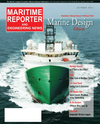
Page 46: of Maritime Reporter Magazine (October 2011)
Marine Design Annual
Read this page in Pdf, Flash or Html5 edition of October 2011 Maritime Reporter Magazine
ulated fire. The boat uses its on-board water cannon to squirt water through a hole in the sign marked as a 'burning' boat. By filling the cup on the other side of the sign, a flag comes up to simulatethat the fire is out. As the boat approaches a make-shift water fall for the water task involved, the boat must get under the spray and pressthe stop button to turn off the water. If the boat isn?t watertight, the water will dis- able the craft.Each boat must be complete with GPSand/or a navigation system, a camera, a propulsion system, a computer and bewater tight to stand the rigors of the com- petition.Teams were judged on ship design and performance. A team can consist of a combination of faculty, industrial and/or government partners and high school, un- dergraduate and/or graduate students, al- though full-time students must composeat least 75% of each team.Fifteen teams entered this year?s RoboBoat Competition and the winnersare as follows: 1st- University of Rhode Island 2nd- University of Central Florida 3rd- Georgia Tech Aerospace Sys. Lab 4th- Virginia Tech 5th- Stevens Institute 6th- Diponegoro University, Indonesia 7th- Georgia Tech Savannah Robotics Special awards went to the following: University of Michigan: Edge of the Envelope for S&T Stretch Stevens Institute: Rookie Best PerformanceCedarville University: Rookie Honorable MentionDiponegoro: Innovation in Design and Cost PerformanceU.S. Naval Academy: ProfessionalismNational Cheng Kung University: Best Paper Other teams entered were CedarvilleUniversity, Embry-Riddle University, Florida Atlantic University, Old Domin- ion University, Villanova University and Virginia Tech. This was the second year for National Cheng Kung University, Taiwan and, de- spite the language barrier, did an excep- tional job of presenting the best paper. But the Dark Horse of this year?s event was definitely the team from Diponegoro University, Indonesia. The Diponegoro University Team, all students of naval architecture, came across the RoboBoat Competition whilesurfing the internet. They quickly real- ized that this was a competition that they could not ignore. They built their boat in 30 days using any and everything they could find lying around. They also found a sponsor in addition to the University?s support, and obtained visas a mere 5 daysbefore the start of the competition. Uponlanding in the United States, they were not allowed to bring in certain parts of their boat. Undaunted and with the self-less help of the U.S. Naval Academy, the Diponegoro University team was able to replace those missing parts from RadioShack. When I asked the team?s lead about all the obstacles they encountered leading up to the sixth place award he replied, ?I have a dream. I want to make roboboat because it is never there for Indonesia. I want to secure our country.? After the awards dinner, the team was headed to Washington, DC to meet with the Indonesian Embassy. They were looking forward to being in our nation?s capital, to visiting the Indonesian em-bassy and seeing and having their pic- tures taken in front of the White House. Despite the language barrier, these young men are a source of inspiration to all they encounter. I expect to see more of Diponegoro University at future compe- titions.SEAPERCH AT ROBOBOAT 2011 The goal of Navy STEM programs is to increase the talent pool of future Sailors,naval scientists and engineers. STEM en- ables the success of naval missions and protects the live of Sailors and Marines. The SeaPerch Program is funded by theOffice of Naval Research (ONR) as part of the National Naval Responsibility for Naval Engineering. SeaPerch is a re- motely operated vehicle (ROV) and an underwater robot that students build from a kit. As part of the SeaPerch program, teachers are trained to build their own SeaPerch. They then go back to their schools and teach their students. The SeaPerch program is now in 38 of the 50 states as part of the curriculum or as anafter school program. Student teams par- ticipate in regional challenges and this year marked the first National SeaPerch Challenge, held at Drexel University in Philadelphia, PA. The earlier we can introduce young stu-dents to robotics and engineering, thebetter chance we have of building a com- petitive team of engineers for America?s future. ?I did robotics in high school andI think that program was a great program. I think that programs like that were very helpful. We had a math and science pro- gram and they did a thing on robotic arms 46Maritime Reporter & Engineering News FEATURE MARINE DESIGNThe Stevens Institute Team walked away with 5th Place and Rookie Best Per- formance at the 4th International RoboBoat Competition. 1st place winners, University of Rhode Island prepares to interview with robotics expert, Zoz Brooks after their success at the 4th RoboBoat Competition. (All Photos by Marlene Stevens)?These teams buildautonomous boats, completely from scratch, that are programmed by the team to makedecisions and perform tasks, without the benefit of remote control, tethers or human intervention. Teams have to pro- gram their boats to make real time decisions, based upon the conditions at hand, so a certain amount of artificial intelligence technique isessential to the successful completion of the competition.? Kelly Cooper, Office of Naval Research MR Oct.11 # 6 (42-49):MR Template 10/5/2011 1:01 PM Page 46

 45
45

 47
47
